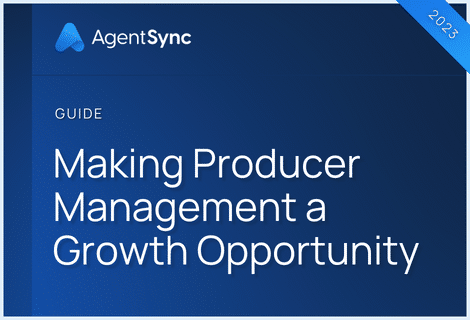

Feb. 14 is the time for declarations of love, professions of devotion, and all-around euphoric adulations to the objects of our enamor. And, for AgentSync, that means the foundation of industry agreement, the paragon of administrative cooperation, the National Insurance Producer Registry.
Frankly, NIPR seldom gets enough recognition for the hard work it does and the impressive amount of coordination and administrative nonsense its staff undertakes to keep carriers, agencies, producers, and state departments of insurance spinning. So, to celebrate Valentine’s Day, we are publishing seven reasons we can’t live without NIPR.
1. NIPR builds consensus with the states
The patchwork of 50-state regulations has some upsides. States can tailor their regulations and general insurance atmosphere to their unique culture. Having 50 states and several jurisdictions each doing their own thing is like having a lab full of Petri dishes for regulation. You can see how different states handle the same situations, and what laws have the intended effect in a given situation.
Yet, for businesses that work in multiple jurisdictions, keeping up with varied regs can get exhausting. NIPR plays a key role in building an insurance industry that works across state lines.
“When NIPR started, it had to do the hard work of going state to state to figure out not only how states self-regulated their insurance producers, but also what technology they used and how to plug these disparate systems together,” said Jenn Knight, CTO of AgentSync. “Our solutions stand on this foundational, unrepeatable work.”
Karen Stakem Hornig, Chief Executive Officer of NIPR, stressed the organization isn’t a regulator. And it isn’t an insurance business. Instead, it’s a place of consensus-building for stakeholders across the industry, a unique position of its own.
“We were created to be like H&R Block,” said Hornig. “We don’t make the rules. We’re built on those rules, we warehouse data in line with the rules, and share the rules and data in the industry. But we’re not a vendor; we’re a unique public-private partnership, a separate corporate organization, a not-for-profit created for a specific purpose.”
2. NIPR establishes a source of truth
Can you even imagine figuring out where an insurance producer was licensed in the days before the producer database?
We’ve got robust imaginations, but that’s less a dream and more a nightmare. By building and maintaining the PDB, NIPR shows they aren’t just a pretty face (metaphorically). They’re the full package.
“The first is the data, without that you can’t do anything else. Being able, over many years, to establish these data processes – at this point 54 states and jurisdictions out of 56 send daily producer licensing transactions through NIPR – is absolutely game changing for the industry,” said Hornig.
While the Northern Marianas Islands and American Samoa don’t yet participate, every other jurisdiction in the U.S. submits data through NIPR’s PDB. It’s mindblowing when you consider that the organization’s been around for little more than a quarter century in an industry that counts time in 100-year spans.
“When producer licensing feels complicated and difficult, I like to look back on where we used to be as an industry and it gives me hope,” said Hornig.
3. NIPR’s expanding features give data life
What began as a single source-of-truth point for data validation between states has grown into a complex system of data transactions, and a Gateway that sends information back and forth. The Gateway turns the static data of the PDB into living, breathing data.
“Producers and end-consumers all benefit from our ability to create ancillary services like contact change requests,” said Hornig. “These are transactions producers would have otherwise had to execute in every single jurisdiction they would want to sell, solicit, or negotiate insurance.”
Since AgentSync’s capabilities essentially extend NIPR’s services, giving them further context and flexibility for our end users, the Gateway, PDB, and NIPR’s ever-expanding roadmap of functions is key to our own development.
4. NIPR shares our commitment to customer excellence
We can’t talk about NIPR’s expanding capabilities without talking about the resources NIPR has poured into providing service to people on every end of the industry.
Regulators? Yep. Carriers? Yep. Agencies? Sure enough. Producers? Indeed. And don’t forget every entity in between.
NIPR gathers information from the states and resurfaces it to all of the stakeholders, which gives state regulators better insight into how other states handle certain processes. But NIPR also answers numerous questions for people in the industry about how to meet compliance standards.
Hornig said over the past decade as the organization has increased the number of states using its services, the customer service team has more than tripled. Keeping pace with the demand for clear, accurate information about licensing and appointments across states is no small thing.
“In 2022, we had over 266,000 calls, emails, chats, and what we consider ‘walk-up’ users, but that doesn’t include our customers and reseller partners,” said Hornig.
As a company that places a heavy emphasis on customer excellence ourselves, the NIPR investment in connecting the industry doesn’t go unnoticed here. Even as NIPR has rolled out new options for people in the industry to get answers to their questions, the phones ring with people who have questions too convoluted for chat or email.
“We have chat, which has helped us meet customers where they’re at,” said Eric Saul, NIPR Chief Technology Officer. “But phone calls are never going away. Compliance is an incredibly complicated thing, and we have to communicate across all demographics. We’re evolving to ensure people can reach us through a variety of modalities.”
5. NIPR leverages technology to serve the industry
We might be biased because we’re an insurance technology company, but we adore how NIPR takes a forward approach to tech adoption in the insurance industry.
“NIPR is perfectly aligned with our goals of connecting the industry through technology, and improving the experience for everyone involved,” said Knight. “They understand that moving to more modern insurance infrastructure involves being really intentional about how that could affect millions of data points in records across dozens of states.”
NIPR has built the foundation for collaboration across the industry, and continues to define what’s possible through its coordination of state systems. Saul said NIPR focuses on tech as one of its core value pillars and is excited to see how emerging technologies can continue to connect the states and incentivize unity and compliance.
“It’s essential to understand that technology is always out front, it’s always beyond our current circumstances,” said Saul. “For instance, as API technology emerged, we started to understand this is a secure way to get super valuable data out to people so they could build their data into every step of the process.”
Saul said when he began working in the industry, it was awe-inspiring to see how passionate people were about compliance, which made him think it was perfectly ripe for technological change.
“These products are personal, if you have to use them you are in a difficult situation, and people in the industry are passionate about protecting people in these difficult circumstances, protecting things that are important,” said Saul. “Anytime you have passionate people trying to help important causes, that’s a sweet spot for technology to enable change.”
6. NIPR facilitates connection in the industry
If there’s a place where producers, agencies, carriers, and regulators all meet, it’s NIPR.
“We see great opportunities to better leverage our unique data and help the industry connect, bringing more insights to our partners to help them be more effective,” said Saul.
In an industry where it can be hard to even get people to agree on basic terminology like “wholesale” and “broker,” this aim of connecting insurance professionals and regulators for a more effective and efficient industry resonates here at AgentSync. We firmly believe that an insurance industry that is quicker, compliant, and connected allows for more accessible and equitable insurance products for consumers.
These downstream effects flow from the work NIPR does to build consensus. As Hornig put it, while NIPR initially arose from Congressional pressure to make insurance producer licensing more uniform, the threat of federalization has been more or less forgotten in the industry.
“We’re well past big-stick threats, but I like to think of NIPR as evangelists for uniformity; we can be a beacon in the industry,” said Hornig.
7. NIPR is the OG of making compliance easier
“Even with all the improvements we’ve made, compliance is still incredibly complex. If you’re an individual producer who manages your own compliance, it’s hard,” said Hornig.
Saul agreed, saying individual producers often call in when compliance has been left unattended for too long. Producers have 99 things to do in a day, and often their license or appointment paperwork gets left for last.
“By the time they call in with a question, urgency is high and the stress level is there,” said Saul. “Part of our goal of leveraging processes in one spot and using tech to help people in the industry get the data they need is that those will enable passionate regulators to focus more time on bad actors.”
Put another way, automating compliance can make it easier to spot the true bad apples, people who “aim to misbehave,” in a sea of well-intentioned people just trying their best to keep up with a complex regulatory landscape.
Truly, NIPR, you are an invaluable partner. You are the foundation of a multi-state compliance effort that makes the industry a better, easier place to work. So, today and every day, be our Valentine?
If you’d like to see how AgentSync leverages NIPR’s data stream for a contextualized, integrated and automated approach to carrier, agency, and MGA/MGU compliance, schedule your demo today.

